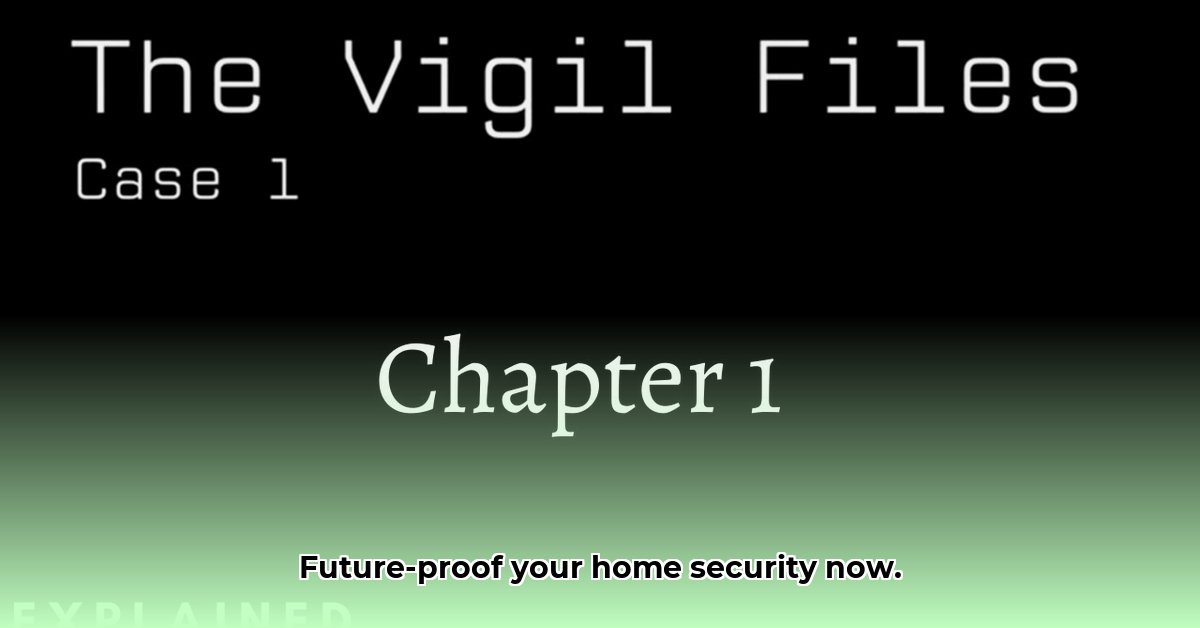
Worried about home security? You're not alone. Millions share this concern, making home security systems a booming market. This guide simplifies choosing the right wireless system, focusing on Vigilos and offering actionable advice. We'll explore DIY vs. professional installation, key features, and potential risks, ensuring you make an informed decision to protect your family and property.
Vigilos: Your 2025 Guide to Smart Home Security
Home security has evolved beyond basic locks. Today, it's about integrating technology for peace of mind. This guide navigates the world of wireless home security systems, highlighting Vigilos' offerings and helping you choose the best fit.
DIY or Professional Installation: The Critical Decision
The first major choice involves installation: DIY or professional? DIY systems, like many from Vigilos, offer cost savings and hands-on control. However, complex systems benefit from professional expertise. Professional installation guarantees a flawless setup and expert support, although it's more expensive.
To decide, consider:
- Technical Skills: Are you comfortable with technology and detailed instructions? Lacking tech skills favors professional installation.
- System Complexity: A simple camera system differs from a complex alarm system with many sensors. Complex systems often justify professional installation.
- Budget: Include professional installation costs in your budget. While DIY might seem cheaper initially, unforeseen problems can increase costs.
Essential Features in a Home Security System
Beyond installation, several key factors influence your choice:
- Camera Clarity: High-resolution cameras with night vision and wide-angle lenses are crucial for clear images, even in low light. Vigilos cameras often boast excellent image quality, but comparing specifications is essential.
- Smart Home Integration: Compatibility with other smart home devices (lights, voice assistants) adds convenience and creates integrated security solutions. Many Vigilos systems offer this integration.
- Storage: Cloud vs. Local: Cloud storage is convenient but may involve monthly fees and privacy concerns. Local storage, often needing additional hardware, offers more privacy but requires more management. Consider your needs and comfort levels with each option.
- Alerting Systems: Multiple alert options (app notifications, emails, texts) ensure timely information. Most Vigilos systems offer a variety of these alerts.
- Data Security: Robust security features (two-factor authentication, encryption) protect your data and privacy. While Vigilos prioritizes security, verify specific features on each model.
Securing Your Home with Vigilos: A Step-by-Step Guide
This six-step plan helps you get started:
- Assess Needs: Identify potential vulnerabilities in your home, considering areas needing extra protection, desired security level, and your budget.
- Explore Vigilos Products: Browse Vigilos' website, examining features, pricing, and user reviews. Compare different models to find the best match for your requirements.
- Compare and Contrast: Don't limit yourself to Vigilos. Compare its offerings with those of other reputable brands. Consider factors like budget, technical skills, and desired features.
- Choose Your System: Select the system meeting your needs and budget. Take your time to make an informed decision.
- Installation (DIY or Pro?): Decide whether a DIY or professional approach is best suited for your technical expertise, level of comfort, and time constraints.
- Test and Monitor: Thoroughly test the installed system, ensuring sensors, cameras, and alerts function correctly. Regularly check for updates and maintain the system for optimal performance.
Mitigating Potential Risks
Even the best systems face risks. Here's how to address common concerns:
| Risk Category | Risk Level | Mitigation Strategy |
|---|---|---|
| Internet Connectivity Issues | Medium | Use a reliable internet connection; consider cellular backup for critical components. |
| Data Breaches | Medium | Use strong, unique passwords, enable two-factor authentication, and keep software updated. |
| Equipment Malfunctions | Low | Regularly check for and install firmware updates. Familiarize yourself with troubleshooting procedures or have a professional contact for assistance. |
| False Alarms | Low | Carefully adjust sensor sensitivity to minimize false alarms; experimentation might be needed. |
Investing in a robust home security system, like those from Vigilos, offers significant peace of mind. By thoroughly researching and comparing options, you'll make an informed decision to protect your family and belongings.
How to Choose the Best DIY Home Security System
Choosing a DIY system can be overwhelming. This section provides a focused guide.
Understanding Your Specific Needs
Before selecting a system, consider:
- Primary Concerns: Burglary, fire, carbon monoxide? This dictates necessary sensors and features.
- Budget: DIY systems have varying price points.
- Technical Skills: User-friendliness varies among systems.
- Monitoring: Will you self-monitor or opt for professional monitoring?
Key Features to Evaluate
Many DIY systems offer similar core features, but differences exist. Consider:
- Sensors: Motion, door/window, glass-break sensors are common. Determine the number needed for comprehensive coverage.
- Cameras: Indoor and outdoor cameras offer surveillance and deterrence. High-resolution with night vision is ideal.
- Smart Home Integration: Integration with other smart home devices adds convenience and security.
- App Functionality: A user-friendly app is crucial for system monitoring and control. Read reviews assessing app usability.
- Storage & Cloud Recording: Determine your video storage needs. Cloud storage, while convenient, usually involves a subscription.
The DIY Installation Process: A Step-by-Step Approach
- System Planning: Strategically place sensors based on home layout and vulnerabilities.
- Tool Gathering: Ensure you have the necessary hardware and tools; most systems include these, but double-check the instructions.
- Careful Instruction Following: Precise placement and wiring are crucial for optimal performance.
- Thorough System Testing: After installation, test all sensors and cameras to confirm functionality.
Weighing the Pros and Cons of DIY Systems
| Pros | Cons |
|---|---|
| Lower upfront costs | Shorter warranty periods |
| Faster installation | Requires technical understanding and effort |
| Feature & plan flexibility | Potential user-error vulnerabilities |
| Self-monitoring options available | May need additional company support |
Remember, a well-chosen and properly installed home security system significantly enhances your family's safety and peace of mind. Thorough research is your best ally in making an informed decision.
⭐⭐⭐⭐☆ (4.8)
Download via Link 1
Download via Link 2
Last updated: Sunday, May 11, 2025